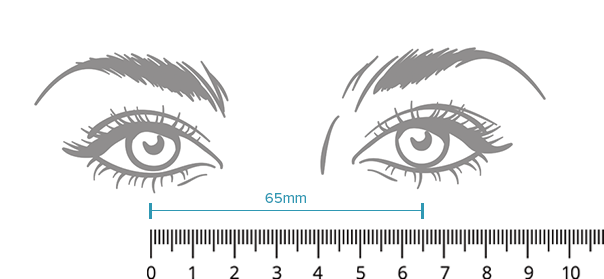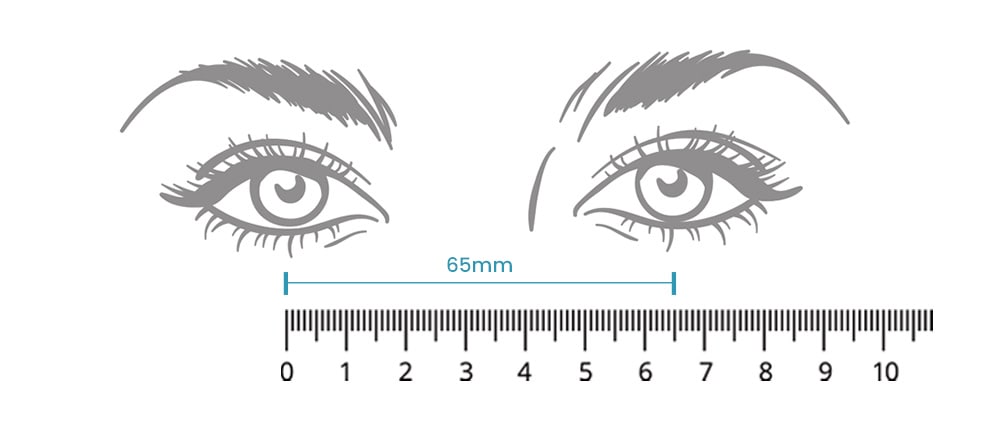How to Measure Your Pupillary Distance

What is PD?
PD stands for Pupillary Distance, which is the measurement from the center of one pupil to the center of the other. Your PD is an important factor and tells you where you look through the lens of your glasses and should be as accurate as possible. For people with strong prescriptions, this is especially important. You can normally find your PD on your prescription. Generally speaking, the PD numbers for adults stay the same. The average pupillary distance range for men is 64mm while the average PD for women is 62mm. For kids, the average PD is about 43-58 mm.


What does PD mean for glasses:
1. Binocular PD is notated as a single number such as "63", which means the total distance between your pupils.
2. Monocular PD is the distance from the bridge of your nose to your pupil on each side. It is notated as two numbers around 30mm such as 31 and 32.
3. Sometimes PD is notated as "61/58". 61 is your distance PD which can be used when you need single-vision distance glasses, bifocal, and progressive glasses. While 58 is your reading PD which can only be used when you need single-vision reading glasses. (The reading PD is normally 3mm less than the distance PD as eyes will get closer when reading.)
Please keep in mind that the PD is not always given as part of your prescription when you have an eye exam. If it’s missing, don’t worry, we can help.

How to measure PD and PD checker
Measuring your PD can be done easily at home, especially with a friend, or a family member. If you are wearing glasses, remove them and look at something 10-20 feet away.



Have your friend hold the PD ruler over your eyes while placing the zero to the center of your right pupil. Read the measurement. The number directly over the center of your left pupil is your PD. Have your friend repeat the measurement a few times to make sure it’s correct.
PD measurement by the PD tools?
It is also easy to measure your PD all by yourself. All you need is your PD ruler and a mirror.
1. Fold your PD ruler so that the side labeled “using a mirror” is facing out.
2. Stand about 8 inches or 20 cm away from a mirror.
3. Hold the ruler over your eyes. And keep the zero over your left pupil.
4. Close your left eye, and open your right eye while looking straight. The number directly over your right pupil is your PD.




Note that: For reading glasses, you can deduct 3mm from your PD measurement.
For additional information, please check out our guides.
Printable PD ruler
Print PD ruler at 100% size. Do not use the 'scaling' or 'fit' setting. The print setting should be the actual size.
Measure against a millimeter ruler to ensure the printout is accurate.

The PD number, or pupillary distance, is the measurement in millimeters between the centers of your pupils. This measurement is crucial for making eyeglasses because it ensures that the optical center of each lens is aligned with your pupils. An accurate PD helps to provide clear and comfortable vision through your glasses. The average PD for adults is around 60mm, with slight variations between men and women. On average, the PD for men is around 64mm, while the average PD for women, is around 62mm. However, individual PD can vary, so it is essential to measure it accurately for the best vision correction.
Can I measure my PD with my phone?
Yes, you can finish the PD measurement online with your phone using certain apps, such as EyeMeasure, specifically designed for this purpose. These apps use the camera on your phone to accurately measure the distance between your pupils. However, it's important to use a reliable app and follow the instructions carefully to ensure an accurate measurement. Alternatively, you can use a ruler and mirror to measure your PD at home.
Why is my PD not on my prescription?
Your PD (pupillary distance) may not be included in your prescription for several reasons. Some eye care professionals do not routinely include PD in prescriptions, especially if you purchased glasses from different providers. Additionally, PD measurements can vary depending on whether you are looking at a distance or near objects, so your eye care professional may prefer to measure it themselves. If your PD is not on your prescription, you can ask your eye care professional to measure it for you or measure it at home using a ruler and mirror.
What if PD is off by 2mm?
A small difference of 2mm in your PD (pupillary distance) measurement is generally insignificant for most people. However, a more accurate measurement can ensure that your glasses provide optimal vision correction and comfort. If you find that your PD is off by 2mm or more, it's advisable to consult with an eye care professional for a more precise measurement. They may also be able to adjust your glasses accordingly to ensure they are aligned correctly for your eyes.
Any other needs or doubts, please feel free to contact us via LIVE Chat!
